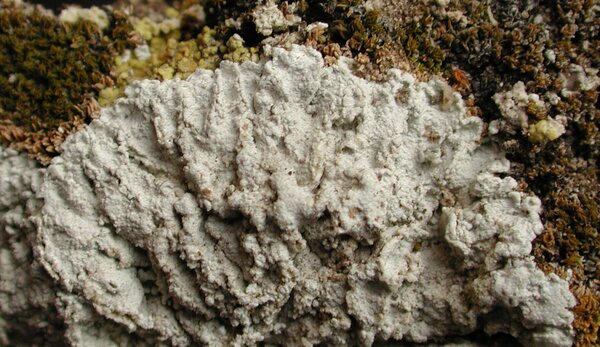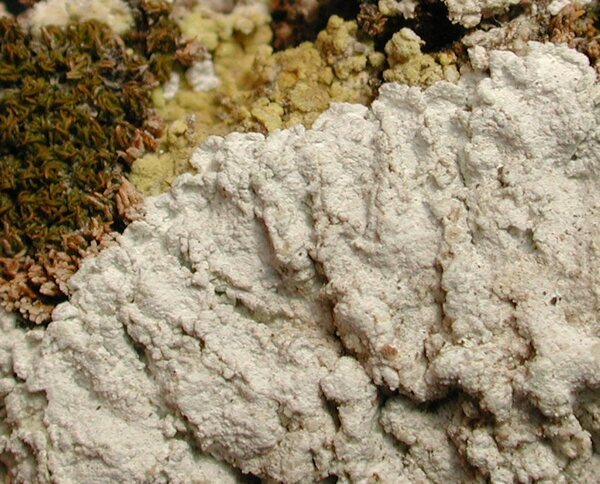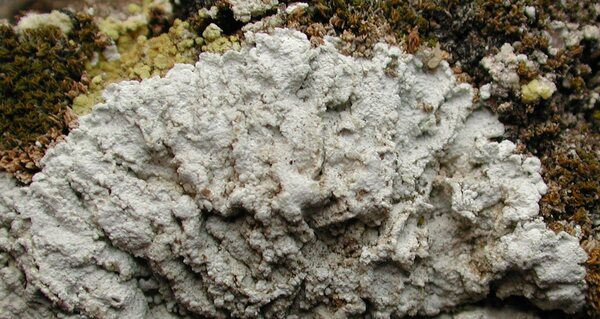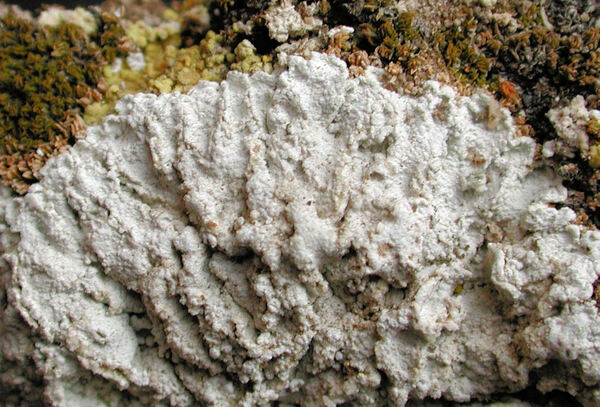Lepraria isidiata (Llimona) Llimona & A. Crespo
in Wirth & al., Guìa de Campo de los Liquenes, Musgos y Hepàticas: 309, 2004. Basionym: Lepraria crassissima var. isidiata Llimona in Vězda - Lich. Sel. Exs., 47: 7 (nr. 1175), 1973.
Synonyms:
Distribution: N - Emil (Nimis & al. 1996, Tretiach & al. 2009, Fariselli & al. 2020). C - Abr (Baruffo & al. 2006), Sar (Leuckert & al. 2004). S - Camp (Baruffo & al. 2006), Cal (Baruffo & al. 2006), Si (Baruffo & al. 2006).
Description: Thallus crustose-subplacodioid to subsquamulose, subleprose, white, pale grey to dark grey in central parts, (0.3-)0.5-1.5 mm thick, well delimited, forming regular, robust up to 8 cm wide rosettes. Marginal lobes well-developed, pruinose, with raised, thick margins, sometimes with subcorticate, paraplectenchymatous patches; hypothallus usually poorly developed, formed by pale brown, hyphae reacting K-; prothallus absent. Central part of thallus coarsely granular, often slightly convex, loosely attached, with a chalky consistency due to rich deposits of calcium oxalate crystals. Granules isidioid, subspherical to ellipsoid, 0.3-0.5(-0.9) mm thick, with a compact outer layer of heavily encrusted hyphae, and no or poorly developed, 40-50 μm long projecting hyphae, eventually dissolving into soredia-like granules. Medulla white, compact; hypothallus compact, composed of tightly intertwined hyphae. Photobiont chlorococcoid. Spot tests: thallus K+ yellow or K-, C-, KC- or KC+ yellow, P+ reddish orange, UV-. Chemistry: chemotype 1: atranorin, protocetraric, fumarprotocetraric and roccellic acids; chemotype 2: atranorin, protocetraric and roccellic acids; chemotype 3: atranorin, fumarprotocetraric and roccellic acids.
Note: on calciferous soil and on mosses in sheltered situations but in sunny and arid habitats, mostly on surfaces wetted by rain, also on gypsum, below the montane belt. For further details see Tretiach & al. (2009).
Growth form: Leprose
Substrata: soil, terricolous mosses, and plant debris
Photobiont: green algae other than Trentepohlia
Reproductive strategy: mainly asexual, by soredia, or soredia-like structures (e.g. blastidia)
Commonnes-rarity: (info)
Alpine belt: absent
Subalpine belt: absent
Oromediterranean belt: absent
Montane belt: absent
Submediterranean belt: rare
Padanian area: absent
Humid submediterranean belt: rather rare
Humid mediterranean belt: very rare
Dry mediterranean belt: rare
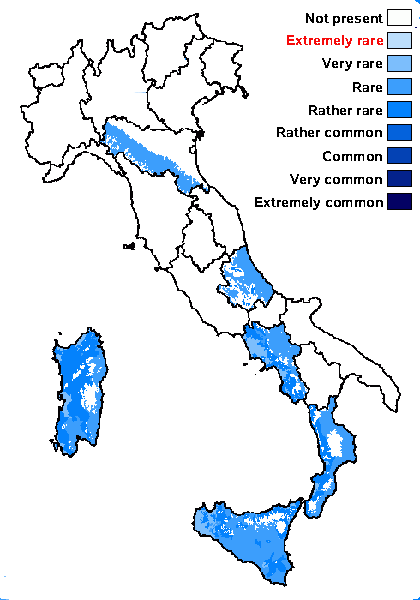
Predictive model
Herbarium samples

Detail from: https://gzu.jacq.org/GZU000291947
GZU000291947 - Collector Llimona,X. Vězda, A.: Lichenes Selecti Exsiccati 1175
Date 1972-11-02
Location Spain / Cataluña
Label Hispania. Catalonia. Prope Igualada loco Coll del Guix dicto ; Alt. 400 m
Habitat Supra terram et saxa gypsacea septentrionem et occidentem versus spectantia, 30° – 90° inclinata.
Growth form: Leprose
Substrata: soil, terricolous mosses, and plant debris
Photobiont: green algae other than Trentepohlia
Reproductive strategy: mainly asexual, by soredia, or soredia-like structures (e.g. blastidia)
Commonnes-rarity: (info)
Alpine belt: absent
Subalpine belt: absent
Oromediterranean belt: absent
Montane belt: absent
Submediterranean belt: rare
Padanian area: absent
Humid submediterranean belt: rather rare
Humid mediterranean belt: very rare
Dry mediterranean belt: rare

Predictive model
| Herbarium samples |

 INDEX FUNGORUM
INDEX FUNGORUM
 GBIF
GBIF
